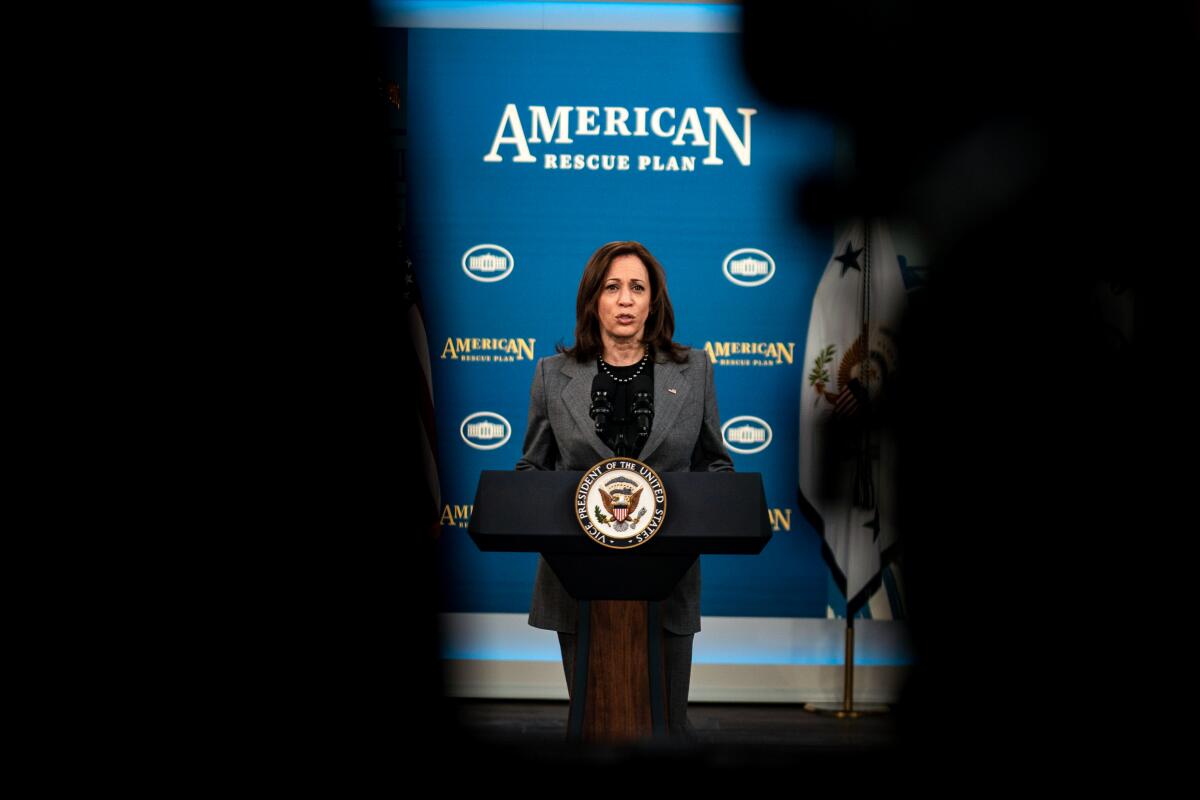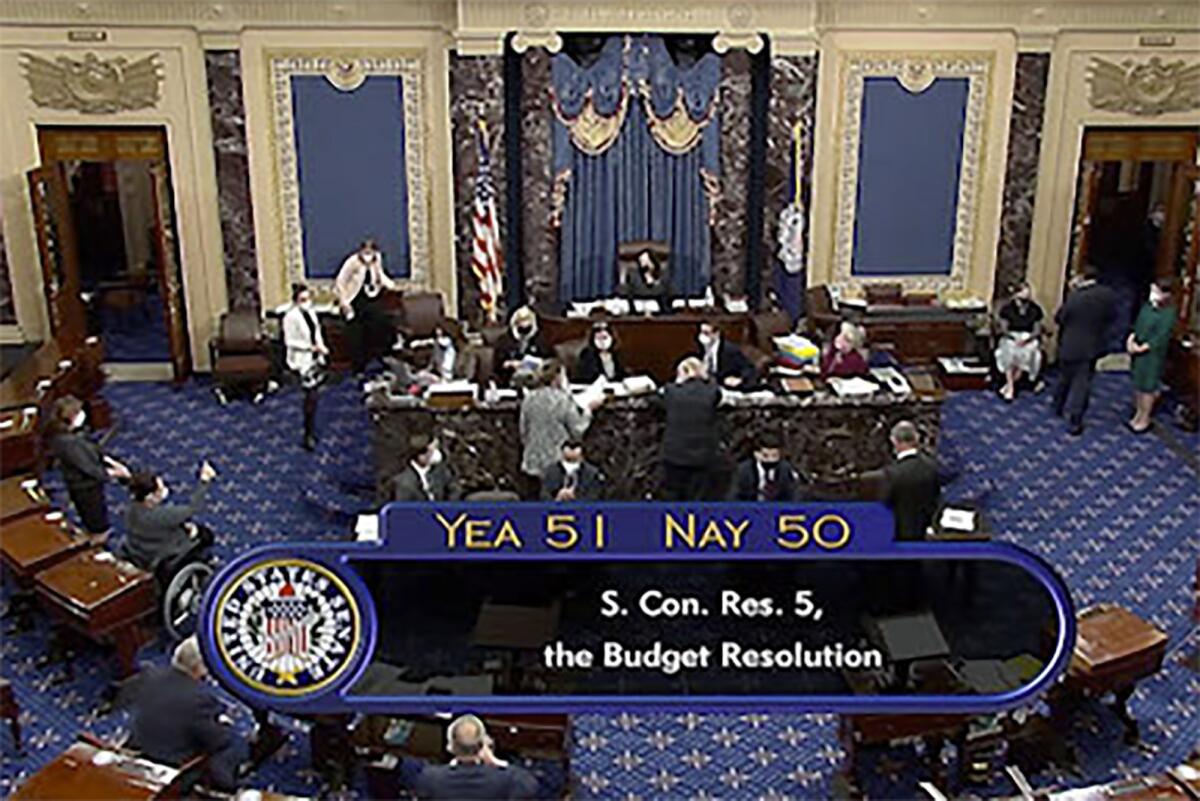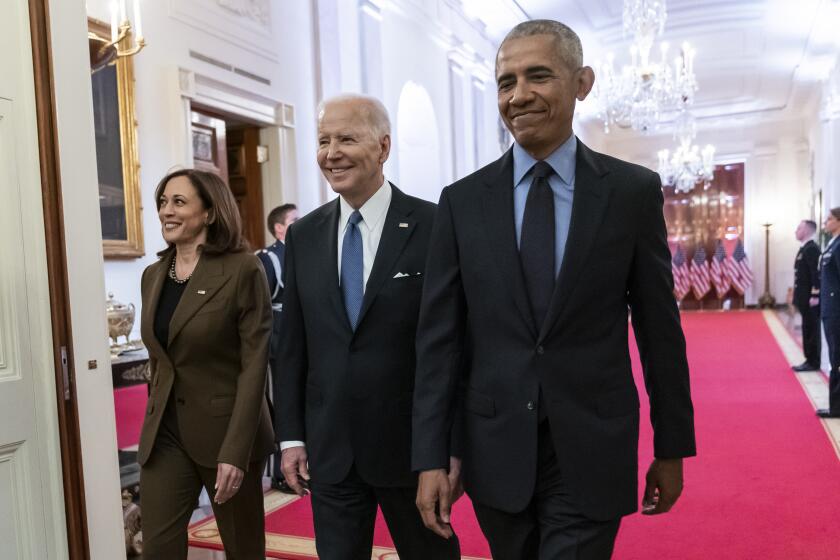Kamala Harris could break a record. Democrats wish she didn’t have to

WASHINGTON — Vice President Kamala Harris is on pace to set an unusual record, breaking the most tie votes in the U.S. Senate.
But many Democrats and progressives don’t see the distinction as much of an honor.
“If this is what victory is, my goodness, guys, we need to want better for ourselves,” said Tre’ Easton, deputy director of Battle Born Collection, a liberal advocacy group.
As vice president, Harris has only a few jobs prescribed in the Constitution — succeeding the president if necessary, presiding over the Senate and breaking tie votes there. The latter requirement enabled Democrats in January 2021 to take control of the evenly split Senate, raising their hopes that they might be able to eke out legislation expanding voting access, guaranteeing family leave to new parents and pouring money into combating climate change.
Instead, they have been largely left frustrated by the party’s inability to pass such key components of President Biden’s agenda, including a bill that would legalize abortion to counter last month’s Supreme Court ruling overturning Roe vs. Wade.
Harris’ tiebreaking votes, in fact, have mostly been needed to unclog procedural gridlock over nominations, highlighting the limits of the Biden administration’s governing power in the face of stiff partisan resistance in Congress.
Her inability to help pass substantive legislation has also increased pressure on Democrats to destroy the Senate filibuster, a rule that requires legislation to win the support from 60 senators before it can proceed to a final vote. They would need support of all 50 Democrats to do that, something that has also been elusive.
For the record:
7:13 a.m. July 5, 2022An earlier version of this article reported that John Adams served as vice president in the 17th century and John C. Calhoun in the 18th . Adams was vice president in the 18th century; Calhoun in the 19th.
Harris has broken 23 tie votes since taking office and has a strong shot at surpassing the record in coming months. The only vice presidents who have broken more ties are John Adams (29) and John C. Calhoun (31), each of whom served two terms in the 18th and early 19th centuries, respectively, when the Senate was less than half its current size.
With a 50-50 Senate split, Harris will be the tiebreaking vote. But her advisors would rather she spend more time at the White House than Capitol Hill.
Harris’ tiebreaking role is unusual in the modern era. The Senate is rarely tied 50-50 for long periods. It last happened more than two decades ago — for less than six months — when Dick Cheney was vice president.
Harris got her opportunity when the Rev. Raphael Warnock and Jon Ossoff won surprise victories in Georgia’s January 2021 runoff elections, allowing Democrats to cobble together their thin majority thanks to the help of two independents.
Despite Democrats’ limited legislative success, the 50-50 split has been valuable for Harris’ party. It has ensured Democrats chair committees, set the Senate calendar and can more easily confirm judges, including new Supreme Court Justice Ketanji Brown Jackson. Harris presided over Jackson’s confirmation vote but didn’t have to cast one — the Senate approved her nomination 53 to 47. That nomination would have certainly hit delays or been rejected if Republicans had controlled the chamber.

Glynda Carr, president of a group called Higher Heights for America that works to elect Black women, said Harris’ role in making history has to be acknowledged. But so does the fact that there currently are no Black women in the Senate. Harris, before she became vice president, was the only one.
“When we celebrated the confirmation of Ketanji Brown Jackson, she presided over that,” Carr said of Harris. “But there were zero Black women sitting there to cast a vote.”
Rep. Karen Bass wants to frame her mayoral campaign as part of a national partisan battle. Not all agree that endorsements from national Democratic figures would help.
Harris’ shining moment as tiebreaker came when she cast the deciding procedural vote in last year’s $1.9-trillion stimulus bill known as the American Rescue Plan, a signature Biden administration achievement. Harris’ vote has also been crucial in ensuring a liberal and diverse cast of nominees got key jobs in regulatory agencies.
But the fact that Democrats have needed Harris for the most basic elements of governing — filling top administration jobs — reveals how badly the Senate has been damaged by the nation’s polarization, said Norm Ornstein, who has studied Congress and is co-author of “It’s Even Worse Than It Looks: How the American Constitutional System Collided with the New Politics of Extremism.”
“You’re getting all Republicans voting against a lot of these confirmations — confirmations that in years past would have breezed through,” Ornstein said. “And now, just for purposes of obstruction, to force the vice president to come to the Senate to cast that tiebreaking vote.”
That dynamic has put enormous scheduling pressure on Harris and all 50 members of the Senate majority. A miscalculation can set plans back weeks, grounding the administration’s work and consuming even more time for lawmakers. It can also take up time in the Senate that could be used on more substantive issues.
In early June, when Harris was in Los Angeles for the Summit of the Americas, Democrats were surprised when it became clear they were not going to muster enough votes to pass the nomination to fill an obscure Department of Labor position.
The vote would have been 50-50, resulting in Senate rejecting the nomination of Lisa Gomez. Senate Majority Leader Charles E. Schumer (D-N.Y.) took a last-minute procedural action that ensured Democrats could more quickly bring up Gomez’s nomination again, when Harris was around to wield the gavel.
Last week, Sen. Patrick J. Leahy’s (D-Vt.) office announced he would need hip surgery, throwing Democrats another potential absence in the coming weeks.
In all, 20 of Harris’ 23 tiebreaking votes have involved confirmations, some of which required her to break ties on “discharge petitions,” ensuring a would-be official or judge could get a Senate vote after a committee had deadlocked on the nomination.

Both sides have increasingly obstructed in recent decades. But Ornstein said Republican Senate leader Mitch McConnell (R-Ky.) maximized the strategy during the Obama administration — sucking up time on procedure that could have otherwise been used for governing. The only thing most voters see is gridlock, which they often blame on the president.
“It gets back to what Mitch said openly: He wants to block every element of the Biden agenda,” Ornstein said. “If things go well and Biden has all of his people in place, that may not serve that goal.”
McConnell’s most notable move was refusing to even hold a hearing in 2016 for then-Judge Merrick Garland, President Obama’s nominee to succeed Justice Anthony Scalia, who had just died. That deed, with 11 months remaining in Obama’s presidency, helped set the stage for the Supreme Court’s ruling last month overturning Roe vs. Wade, the landmark decision that legalized abortion. Three of President Trump’s Supreme Court nominees, including the one who took Scalia’s seat, joined in that historic 5-4 majority opinion.
Republicans say Democrats also exploited rules to force additional procedural votes on many of Trump’s nominees for dozens of executive branch jobs that had not previously been subject to them. A spokesman for McConnell pointed to the senator’s previous comments that the two parties would have to find common ground during the Biden presidency “between the 40-yard lines” because the House and Senate are so closely divided.
Harris, despite some frustration that voting rights and other priorities have been stymied, has tried to celebrate her history-making role. Her advisors say she uses the time in the Senate to build relationships.
For example, she recently spoke with Sen. Martin Heinrich, a New Mexico Democrat, about wildfires. She looked at baby photos with Ossoff, a new father. She has engaged in sideline discussions with Sen. Roy Blunt, a Missouri Republican with whom she served on the Intelligence Committee when she was in the Senate.
“Casting tiebreaking votes is about advancing Biden-Harris policies that lift up workers and strengthen the middle class — from casting tiebreaking votes that led to a successful vaccination campaign and record job growth to confirmation votes that have led to the most diverse group of judges in American history,” spokesman Herbie Ziskend said.
If Harris breaks the record for tiebreakers, it would be one of history’s great ironies. The first woman of color in nationally elected office, Harris would overtake Calhoun, an avid defender of slavery and one of the U.S. government’s most prominent racist figures in history.
More to Read
Get the L.A. Times Politics newsletter
Deeply reported insights into legislation, politics and policy from Sacramento, Washington and beyond. In your inbox three times per week.
You may occasionally receive promotional content from the Los Angeles Times.












